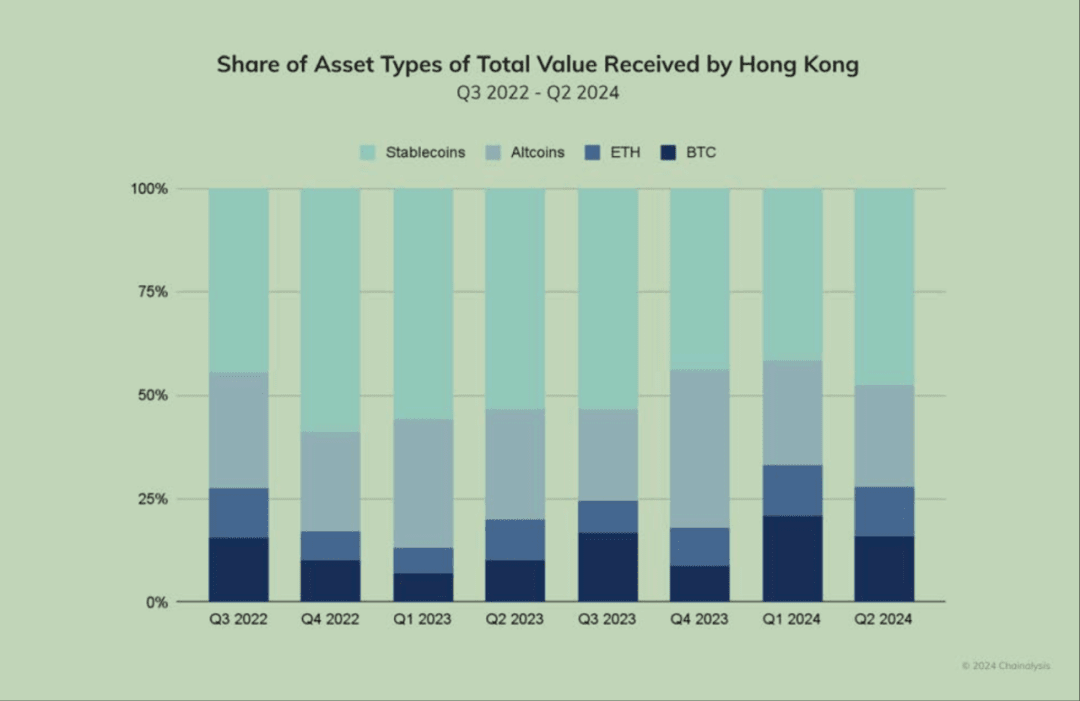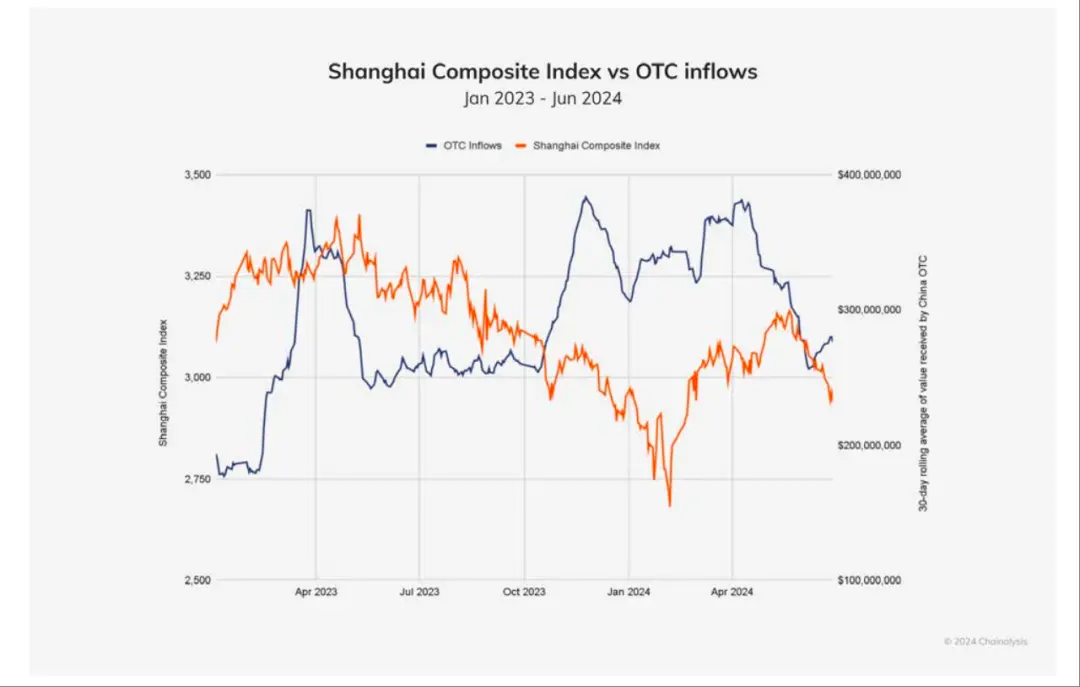Author: Mankin Blockchain
Reprinted from: White55, Mars Finance
In recent months, stablecoins have absolutely been the hottest topic in the financial and crypto circles! The United States and Hong Kong have successively passed legislation supporting stablecoins, and internet giants and established financial institutions have joined the fray, either hoarding coins or applying for licenses, as if a sudden spring breeze has come, blooming a thousand trees of pear flowers. In contrast, the Mainland of China currently shows no signs of loosening policy, as if firmly sitting on a fishing platform. Among this, a widely circulated news about the large-scale use of stablecoins in Yiwu cites two main sources: Huatai Securities research reports showing that stablecoins have become an important tool for cross-border payments in Yiwu, and blockchain analysis firm Chainalysis estimating that the on-chain stablecoin flow in the Yiwu market will exceed 10 billion US dollars in 2023.
Interestingly, when reporters conducted on-site research, most merchants said they had not heard of stablecoins or did not understand them. A few merchants expressed doubts about the compliance and costs of stablecoins, and only a small number of merchants explicitly stated that they had used stablecoins for payments. The scene felt somewhat like the elderly man downstairs answering Charlotte's questions with a sort of mysticism. What is the true situation? Let’s dig into the two sources of information.
Huatai Securities Research Report
Based on publicly available information, the author has not found media sources that provide the specific name and origin of Huatai Securities’ research report. However, with the help of friends, the author found a macro securities research report published by Huatai Securities on June 25 titled "How Will Stablecoins Affect the Global Monetary System?" In this 31-page report, Huatai Securities systematically elaborates on the development prospects and risks of stablecoins globally through eight chapters. On page 8 of the report, there is a statement regarding the usage scenarios of stablecoins:
"In addition to being used directly for trading crypto assets, the proportion of stablecoins in global commodity and service transactions, their role as a means of value storage, and the penetration rate among residents are rapidly developing. Specifically, in Yiwu, the world’s small commodity center, stablecoins have become an important tool for cross-border payments. Blockchain analysis firm Chainalysis estimates that the on-chain stablecoin flow in the Yiwu market will exceed 10 billion US dollars in 2023."
However, unlike other viewpoints in the report that are supported by data charts, this viewpoint does not have data support attached.
Overall, the report is quite readable, and here are some viewpoints selected by the author:
1. Countries representing large monetary totals with strong legislative push demands, such as the United States (dollar hegemony), the European Union (unified market), and China (potential market), see a huge market scale for stablecoins; countries like South Korea, which are advanced in digital and virtual economies, and Singapore, which has high openness and strong external dependencies, will have high penetration rates for stablecoins; emerging market economies like Turkey, Argentina, and Nigeria, characterized by low currency stability, underdeveloped banking systems, significant underground economies, and capital flow restrictions or sanctions, will also experience high penetration rates for stablecoins.
2. In response to the challenges posed by the development of stablecoins, major economies typically adopt either issuing digital currencies or strengthening the regulation of stablecoins as their two main responses. For Mainland China, research on digital currencies began as early as 2014, and pilot programs were initiated in 2019. With the rapid development of stablecoins, especially the stablecoin legislation in Hong Kong set to take effect in August this year, it may signify China's shift towards a "dual-track" development path. The central bank's leader clearly stated at the Lujiazui Forum on June 18 that emerging technologies such as blockchain and distributed ledgers are driving the vigorous development of central bank digital technologies and stablecoins, indicating a noticeable increase in the central bank's attention to stablecoins.
3. The legislation for stablecoins in Hong Kong is expected to accelerate the development of Hong Kong dollars, offshore renminbi, and even renminbi stablecoins, providing further impetus for the appreciation of the renminbi. Measures such as expanding the "funding pool" of Hong Kong dollars and offshore renminbi, enriching high liquidity assets such as interest rate bonds available for investment, vigorously developing cross-border business, the digital economy, and the virtual economy, and increasing use cases for stablecoins are key to the success of Hong Kong's stablecoins and will reactivate the process of renminbi internationalization.
4. Stablecoins pose challenges to cross-border financial regulation while also facing certain levels of redemption risk. When the value of reserve assets fluctuates, the credit of the issuing entity is challenged, or even in the case of bankruptcy of the issuing entity, fiat stablecoins may also experience a loss of value. As the scale of stablecoins expands and their impact on the traditional financial system deepens, it may ultimately require accepting stricter regulations and even partial nationalization in exchange for true stability.
Data analysis by Chainalysis.
Unfortunately, the author has not found any references in media or from Chainalysis regarding the use of stablecoins by Yiwu merchants through searches on both domestic and foreign networks for the 2023 and 2024 (Crypto Geography Report).
The author has also selected some data and viewpoints from two reports by Chainalysis regarding Mainland China and Hong Kong.
1. For a long time, the proportion of stablecoins in the value of crypto assets received by users in Hong Kong has remained above 40%. With the legislation on stablecoins in Hong Kong set to take effect in August this year, this proportion is expected to rise further.

Figure 1 The proportion of stablecoins in crypto assets received in Hong Kong is high - Chainalysis
2. Data shows that Chinese users utilize crypto assets to preserve and increase their wealth.

Figure 2 Comparison of the Shanghai Composite Index and OTC inflow from January 2023 to June 2024 - Chainalysis
In the author's view, whether stablecoins are used on a large scale in Yiwu may lack accurate data verification, but the combination of foreign trade and stablecoins does have inherent advantages. The features of stablecoin payments, such as instant settlement, stable value, and low rates, address many pain points for small and medium-sized foreign trade merchants.
However, on the other hand, considering the regulatory policies of Mainland China regarding stablecoins and other crypto assets, if Mainland foreign trade merchants directly use stablecoins during transactions, there may be serious compliance issues, and even potential criminal risks.
Moreover, considering that the current export tax rebate policy in our country often requires providing a bank’s foreign exchange settlement certificate, using stablecoins would mean that this certificate cannot be provided, thus foregoing the export tax rebate, which is fatal to merchants' profits. On the other hand, participation qualifications for exhibitions such as the Canton Fair usually consider the bank transaction records of export enterprises as an important reference standard, and commercial banks’ lending review standards also place significant emphasis on the bank transaction records of export enterprises. These factors determine that, at present, the scale of stablecoin usage among Yiwu exporters will not be very large.
So, how can Mainland foreign trade merchants compliantly utilize stablecoins to reduce costs and increase efficiency? Currently, a relatively compliant method is to leverage the connectivity between Hong Kong companies and Mainland companies, utilizing Hong Kong's external trade conveniences and open policies on crypto assets to achieve compliant integration of traditional foreign trade and crypto payments.
Hong Kong dollar stablecoins and feasible compliant foreign trade models utilizing stablecoins.
On August 1, the Hong Kong (Stablecoin Regulation) will officially take effect, and the Hong Kong government will begin accepting license applications for the issuance of stablecoins in Hong Kong. This means that stablecoins recognized by the Hong Kong government will officially launch, and Hong Kong dollar stablecoins will be considered a legal means of payment, making exchanges between Hong Kong dollar stablecoins and fiat currency more convenient and compliant.
1. The 100% redeemability requirement for Hong Kong dollar stablecoins.
Hong Kong (Stablecoin Regulation) stipulates that issuers of stablecoins must ensure that the stablecoins they issue have sufficient reserve assets to support them, ensuring that the market value of the reserve assets is not less than the nominal value of the stablecoins issued and in circulation.
Stablecoin issuers should ensure that stablecoin holders have the right to redeem and must not obstruct or restrict the redemption of stablecoins, nor charge any fees other than reasonable service charges during the redemption of stablecoins.
2. Hong Kong dollar stablecoins meet compliance requirements for anti-money laundering and anti-terrorism financing.
Hong Kong (Stablecoin Regulation) stipulates that issuers of Hong Kong dollar stablecoins must comply with strict anti-money laundering and anti-terrorism financing requirements.
In a consultation document released by the Hong Kong Monetary Authority on May 26, the authority outlined the relevant anti-money laundering and anti-terrorism financing requirements, with core requirements including:
Customer due diligence. Customers making purchases or redemption transactions that reach or exceed the benchmark of 8,000 HKD must undergo due diligence, including verifying wallet ownership;
Strict regulation of non-custodial wallets. Implementing strict monitoring, transaction limits, and other measures to reduce the risk of wallets being exploited by criminals;
Continuous monitoring. Using blockchain analysis to track transaction history and detect illegal activities, reporting suspicious transactions;
Conduct due diligence on custodial wallet providers;
Blacklisting illegal wallet addresses.
3. Key points for Mainland foreign trade merchants to compliantly utilize Hong Kong dollar stablecoins.
Considering the current policy differences between the Mainland and Hong Kong regarding stablecoins, the author believes that Mainland foreign trade merchants can avoid most compliance risks by grasping the following three key points when utilizing Hong Kong dollar stablecoins:
Utilizing Hong Kong or other offshore corporate entities to receive and make payments in stablecoins;
The compliant exchange of stablecoins and fiat currency is completed in Hong Kong;
Compliance in converting fiat currency back to the Mainland parent company;



